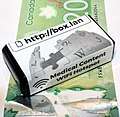Internet-in-a-Box
Internet-in-a-Box is a low cost digital library, consisting of a wireless access point with storage, which users nearby can connect to.[1]
 The 2017 set up of an off line medical library. Anyone physically near to the device may connect to it and download the offline content it contains. |
Its realization in hardware and software has changed since 2012, as miniaturization of storage space and electronics progressed.[2] As of 2017, its hardware may consist of a Raspberry Pi with a replaceable storage card.[1]
In 2016, Columbia University's Masters in Public Administration in Development Practice (MPA-DP) explored using these boxes in Dominican Republic for three months.[3]
Digital library
The digital library is composed of multiple modules; modules may be pre-installed, or users may choose which to install. Examples of modules include Wikipedia in a specific language, Wikipedia's Medical Encyclopedia, Khan Academy lite, and OpenStreetMap.[3][1] Other content includes OpenStreetMap, Moodle, Owncloud, PhET (interactive mathematics and science simulations), TED Talks.[4]
History
The concept grew out of One Laptop per Child's school server project.[1]
 2017 version of IIAB with medical content
2017 version of IIAB with medical content An older version of offline Wikimedia content and a WiFi transmitter.
An older version of offline Wikimedia content and a WiFi transmitter. Internet-in-a-box 2019 version compared to passport
Internet-in-a-box 2019 version compared to passport
See also
References
- Watkins, Don. "How to create an Internet-in-a-Box on a Raspberry Pi". Opensource.com. Retrieved 14 August 2017.
- Gaskill, Braddock (2014). "Internet in a Box" (PDF).
- "Internet-in-a-Box: Connectivity for the Rest of the World". 13 June 2017. Retrieved 14 August 2017.
- "How to create an Internet-in-a-Box on a Raspberry Pi". Opensource.com.
| Wikimedia Commons has media related to Internet in a Box. |